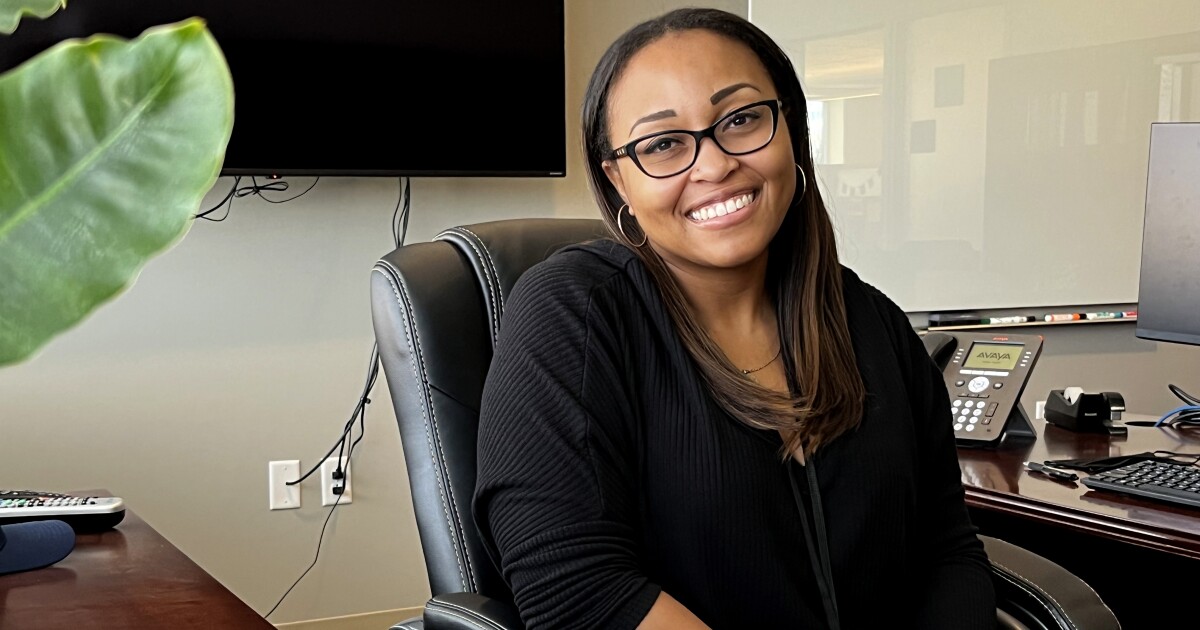[ad_1]
As an intensive care nurse in a Portland cardiovascular unit, Jazzy Walker lived through the COVID burnout that’s driven nurses from the industry and exacerbated widespread nursing shortages across Oregon’s healthcare system.
She watched as some of her most seasoned colleagues broke down under the strain of heavy workloads with increasingly sick patients, and she felt team dynamics change as hospitals called in short-term travel nurses to fill staff gaps.
When the stress got to Walker, prompting panic attacks and sleepless nights, she decided to move from bedsides to academia and focus on building the future nursing workforce.
Four months into her job as the nurse administrator at Clackamas Community College, Walker is up against the chicken and egg situation impeding Oregon’s higher education institutions from meeting healthcare industry needs.
Nurses can’t make as much money teaching as they do helping patients, which makes nurse educators hard to hire. That instructor shortage limits the number of students that nursing programs can enroll, preventing Oregon colleges from graduating enough nurses to meet state workforce needs. Short staffing in both settings means fewer nurse educators are available to train students in hands-on clinical settings, further limiting the number and experience of nursing grads.
“It is a very ugly cycle,” Walker said.
Oregon’s nursing programs produced the third fewest graduates per-capita of any state in 2020, according to the Oregon Longitudinal Data Collaborative, which analyzes data across Oregon’s education and workforce landscapes.
“Most of our schools have programs. It’s a capacity issue,” said Tracy Thompson, policy analyst for nursing education at the Oregon State Board of Nursing. “There’s no faculty to support additional students.”
An upcoming report from the collaborative, expected in February, will recommend that the state convene a workgroup to address nursing faculty pay and establish a centralized clinical placement system. Nurse educators are also looking to legislators for policy changes that could fix kinks in the workforce pipeline for a critical state industry.
“If we can get incentives to clinical partners, and if there’s a way for the state to help fund nursing educator’s salaries and program administrators, that would really help with two of our problems,” Walker said.

Ali Oakley, a second-year nursing student at Clackamas, talks to peers about a case study. Clackamas administrators would like to expand the nursing program to help address industry staffing shortages but are limited by a shortage of nursing educators.
LIMITED CAPACITY
Oregon has 17 associate degree programs for students who want to become registered nurses, as well as six public and private bachelor’s degree programs and another eight community college programs for licensed practical nurses, who have less schooling than a registered nurse.
In 2020, 409 students graduated from practical nursing programs, 606 students from associate degree nursing programs and another 929 students with a bachelor’s degree in nursing, said Ben Tate, director of the Oregon Longitudinal Data Collaborative.
Still, the data collaborative estimated that Oregon needed more than 1,000 additional graduates to meet workforce needs that year, according to a draft summary of its upcoming report.
Schools have enough applicants to more than double their capacity. Oregon’s nursing schools received more than 6,000 applications in 2020, but accepted less than a quarter of them, the draft summary says.
Clackamas Community College sometimes gets more than 300 applicants for an average of 30 open spots, Walker said.
“To turn down that many potential nurses is a very hard thing to do,” she said.
Jennifer Limones, 36, is in her second year of the Clackamas nursing program and is planning to enter the profession full-time this summer. She spent several years working and taking prerequisite courses before she applied for the associate degree program in nursing, inspired by the impact of nurses who took care of her 4-year-old son when he needed a kidney operation at Randall Children’s Hospital.
Limones, who has worked as a medical assistant for 15 years, was accepted to the Clackamas program on her first try. She knows that’s an unusual feat.
“There are so many capable and qualified prospective nursing students who are not making the cut and it isn’t for lack of qualifications or ability. These are not incapable or incompetent prospects,” Limones said. “There are only so many seats and it really becomes discouraging.”
Walker hopes to expand Clackamas’ open seats. In a perfect world, she’d offer 36 spots next fall and work to open 40, maybe 60 in the long-term.
But this fall, Clackamas didn’t even have enough teachers for its typical enrollment. The school cut its usual 30 slots down to just 18, Walker said.
“Trying to advertise and get nurses at the bedside to come teach with our students is like pulling teeth,” Walker said. “They can’t afford financially to take that pay cut, so they’re not going to come on full-time.”

Daniel Bulek, a nursing instructor and simulation coordinator at Clackamas Community College, works with second year nurses during a lesson Jan 9. Oregon’s public colleges and universities struggle to find enough qualified instructors to teach aspiring nurses, limiting the number of graduates that Oregon prepares for the workforce. Sami Edge/The Oregonian.Sami Edge
NURSE EDUCATORS MAKE LESS
Walker nearly turned down her position at Clackamas when the first offer from the school came in $30,000 lower than what she made nursing full-time.
Without picking up extra shifts, Walker could pull in $90,000. With extra shifts she made over $100,000. Full-time faculty at the school make somewhere between $60,000 and $80,000 by comparison, Walker said.
Nursing program administrators around the state are hamstrung by that challenge. Janie Griffin, director of nursing at Columbia Gorge Community College, reminds prospective teachers that they get summers and most weekends off and can take nursing shifts on the side.
“When you look at an ad and you see I’m going to make $20,000 less, (nurses say) ‘I’m not even going to apply,’” Griffin said. “I don’t know, how do we catch them and hook them and bring them in and say ‘Give it a try, I think you’ll like it?’”
Oregon Health and Science University is working to boost the ranks of nurse educators through its Oregon Nursing Education Academy. The academy aims to train 63 new faculty members and 92 new supervising clinicians with a $4 million federal grant. Nurses accepted to the academy will receive scholarships that cover the majority of tuition.
Several lawmakers have proposed bills in the 2023 session that would extend income tax credits for rural medical providers to nurse educators. A similar effort died in committee in 2019.

Linfield nursing students practice on medical mannequins in a simulated emergency room setting in the school’s Experiential Learning Center. The high-tech manikins can simulate hemorrhages, neurological symptoms and even give birth. Courtesy Timothy Sofranko, Linfield University.Timothy D. Sofranko/Linfield University
FEW CLINICAL SPOTS
Nursing students need hands-on practice to finish their schooling, but a lack of faculty and working nurses means there are too few mentors to guide students in clinical settings. The shortage of clinical placements became acute during the COVID-19 pandemic, when many healthcare facilities closed to visitors.
Deb Henry, a nursing education and practice specialist at Legacy Health, said the hospital system offered 2,607 clinical spots for nursing undergraduates in fiscal year 2020, then only 468 in 2021. Clinical spots rebounded to 1,110 in 2022 but are still not back to pre-pandemic levels because of staffing shortages.
Hospital units that have several nurse openings can’t accommodate as many students, Henry said, and will prioritize onboarding new Legacy hires or traveling nurses before training students.
“We try hard, I try hard, to place these students but there are so many variables involved that it’s difficult,” Henry said.
The Oregon State Board of Nursing allows schools to substitute simulated nursing scenarios – like working with high-tech mannequins, case studies or actors – for up to 49% of a student’s clinical hours, Thompson said. Some schools have leaned into that option.
The Linfield School of Nursing expanded simulation centers during the pandemic to help meet students’ needs for clinical experience. Spending time alongside professional nurses in real health care settings helps prepare students to work face-to-face with patients, but the hours can be unpredictable, associate dean of nursing Julie Fitzwater said. Simulations let instructors craft the exact experience they want their students to work through, like caring for a mannequin that has given birth and is suffering a post-partum hemorrhage or interacting with an actor simulating a patient in a mental health crisis.
“Having both experiences is so important for building their clinical reasoning and clinical judgement,” Fitzwater said.
This story was brought to you through a partnership between The Oregonian/OregonLive and Report for America. Learn how to support this crucial work.
Sami Edge covers higher education for The Oregonian. You can reach her at sedge@oregonian.com or (503) 260-3430.
[ad_2]
Source link



